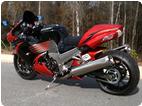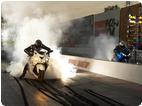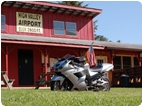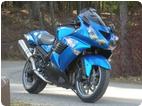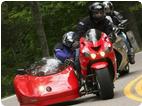Front and Rear Suspension Removal - Gen1 with
Ohlins Shocks and Forks Installation
You may use this tutorial for the installation and removal of either the OEM suspension or Ohlins. The procedures are identical for both except for a few minor differences. Where differences between installtion of Ohlins and OEM suspensions exist, I have mentioned them in the following instructions.
Related thread:
Tools:
front and rear stands that do not support the bike under the suspensions
tape measure
inside calipers
6mm allen key
12 inch zip ties
safety bumper (rolled up towel or other soft objects)
6mm allen key
six point 10 mm socket
wide straight slot screwdriver
electrical tape
millimeter steel ruler
water and a rag
torque wrench
phone books (or other object to support the swing arm and wheel)
14 mm box end wrench
12mm box end wrench
six point 19 mm socket
4” extension
30” breaker bar
floor jack
14mm socket
5” extension
two 24mm open end wrenches
WD40
soapy water
old pair of socks
rear spool stand
8mm allen key
M10 x 1.25 mm bolt, at least 35mm shank
4mm allen key
2 passenger foot peg bracket mounting bolts, ~10mm longer than OEM, with 2 nuts
2 P-clips
Do first:
Measure the sag of the bike (see Suspension Tuning, Gen 1, steps 1 -11) to compare to the new suspension if you will not be reinstalling the OEM suspension.
This is optional step but I recommend doing it for a good view-- Remove the lower fairings, foremans, sides fairings and the top fairing (see Fairings Removal)
Lift the bike on front and rear stands that do not support the bike under the suspensions. A swing arm pivot stand will work perfectly to remove the rear suspension. I used a steering pivot stand for the front. Make sure that the front stand you use has enough clearance to permit the forks to drop.
The fork will need to clear the side bar of the stand 
and it will need at least 12 inches to drop out of the fork clamps. Ohlins forks are a little longer so they will require an additional half inch or so of clearance from the floor.
Remove front fender and front wheel (see Front and Rear Wheel removal, steps 1-12
Front Forks Removal
1. You will need to know the exact height that the forks are held in the clamps in order to reinstall them. Use a tape measure to find the distance between the bottom of the triple tree fork clamps and the top of the fork. This is a rough measurement. The triple tree fork clamps may not be perfectly square and it is not possible to lay the tape measure flat against the fork. It is still a good long distance to check when you reinstall the forks. Measure both sides and write down the measurement immediately. 
My measurement was12 1/16 inches from the bottom of the triple tree fork clamps to the top of the fork cap. This is how they were installed by the factory.
An inside calipers is the tool to use to measure the fork height more accurately. Lay a flat object across the fork cap and place the calipers blades between it and the top of the handle bar holder. Measure a spot right in front where the top of the handle bar holder levels out. Measure both sides and write it down. This measurement is good to take for reference but be aware, the top of the handle bar holder is curved so the height varies all around the fork. This cannot be taken as a one hundred percent true measurement but it’s a good one to keep track of for when you install the forks. 
My clipon to fork top measurement was 5mm. Even though it may be less than precise, this actually ended up being the measurement I relied upon the most for installing the forks.
2. Use a 6mm allen key to remove the handle bar mounts from the top crown clamp.
You do not need to disconnect any wires or lines but you should zip tie them so that the air in the reservoir does not reach the tube at the bottom and go into the master cylinders. The brake fluid reservoirs shouldn’t leak, but keep an eye on this just in case. You can loosely bolt them back on if you need to leave your work unfinished for a while. 
3. The way to get the true measurement of the fork height is to use calipers to measure
from the top of the clamp on the fork crown to the top of the fork cap. The top of the crown clamp is flat and parallel to the top of the fork cap so this measurement should be very reliable. Measure both sides and write it down.
The service manual says stock height of the front forks is 21.5 mm (0.85 in.) from the top of the fork cap to the top of the top crown fork clamp.
My factory installed fork height was 24mm above the top crown clamp.
4. Place some kind of safety bumper under the fork. A rolled up towel or some plastic or wood object should do fine.
It is very doubtful that a fork could fall out even if all the clamps are loose but better safe than sorry.
5. Use a 6mm allen key to fully loosen the top fork clamp. 
If you will be disassembling the fork, The service manual procedure is to loosen the top fork clamp first, then loosen the fork top plug before proceeding with fork removal or disassembly.
6. Use a six point 10 mm socket to fully loosen both bolts on the triple tree fork clamp. Loosen the bolts evenly a little at a time. Unthread them so that they are very loose or take them out.
7. Cover the blade of a wide straight slot screwdriver with electrical tape. Hold the fork
tube in one hand and insert the screwdriver tip between the halves of the fork clamp. Do not insert against the screw threads. Twist the fork slightly while applying a gentle twist to the screwdriver to spread the clamp just a hair or two (don’t bend your clamps!). The fork will slide down a little at a time as you repeat these motions. After the fork drops about 6 inches, the top tube narrows. Be careful that it dose not fall out of or get cocked in the clamp. If you take your time, the finish will not have a single scrape. The anodized surface is pretty amazing. 

DO NOT WIPE ANY DIRT OR GRIME FROM THE FORK AS YOU REMOVE IT. IT MAY PROVIDE USEFUL INFORMATION SOON.
8. Repeat staps 4-7 for the other fork leg.
Front Forks Installation
OEM forks and Ohlins FGRT-807 forks are installed exactly the same way and should be installed to the same height.
9. If you did not wipe the dirt from the fork, there will be a record of the fork height left
provided the fork has gotten dirty enough. After you measure the marks with a millimeter steel ruler and write them down, you can clean the forks up. I left the dirt marks on mine.
The marks of the handle bar holder and top crown clamp.

The marks of the triple tree clamp measured from the top of the fork cap.
10. Use water and a rag to clean away dirt from the top crown clamps and the clipons 
Clean the lower fork clamps, too.
11. Perform the same procedure as described in step 7 to begin installing the fork. You
can start with a folded towel on the floor as a safety bumper or have the objects you used to remove the forks ready to place under the bottom of the fork. When it starts into the lower clamp, it should stay. Work the fork all the way up into the top crown clamp.
12. Repeat step 3 to determine if you have the fork at the proper height. Adjust as
needed. Snug up the lower clamp bolts a little at a time so the clamp tightens evenly. Snug up the top clamp. 
Ohlins forks are installed the same height in the top crown clamp as OEM forks. According to the service manual, stock height from the top of the top crown clamp to the top of the fork cap is 21.5mm. I set my forks at 24mm high because that is how I found them to have been installed by the factory.
13. Install both handle bar holders, snug up the bolts and repeat steps 2 and then 1 to
verify that the fork is installed at the the proper height. Torque the clipon bolts.
Torque: Handlebar Holder Bolts, 18 ft-lbs

Installed at 24mm above the top crown clamp, my Ohlins fork tubes were about 1mm above the front of the clipons.

Here’s what the forks looked like below the triple tree. As you can see, you would not want to raise the forks much higher in the clamps.
14. Repeat steps 10 through 13 for the other fork leg.
15. Do not remove the bike from the front stand without torquing all fork clamps bolts to
spec. Turn the steering from lock to lock to visually inspect clearance of all wires, cables and hoses.
16. Torque the triple tree fork clamp.
OEM:
Torque - Front Fork Clamp Bolts (Lower): 30 N·m (3.1 kgf·m, 22 ft·lb)
Ohlins:
Torque - Front Fork Clamp Bolts (Lower): 10 N·m (7.37 ft·lb)
That’s not a typo, just 7.37 ft lbs. I verified this both with Dan Kyle and Ohlins. The FGRTs are not designed to take more compression from the clamps.
Torque the fork plug if it was removed prior to installation.
Front Fork Top Plugs: 22 N·m (2.2 kgf·m, 16 ft·lb)
Tighten the top fork clamps.
OEM:
Front Fork Clamp Bolts (Upper): 20 N·m (2.0 kgf·m, 15 ft·lb)
Ohlins:
Front Fork Clamp Bolts (Upper): 20 N·m (2.0 kgf·m, 15 ft·lb) Same torque as OEM.
17. Install fairings (see Fairings Removal) and loosely install front wheel and front brake calipers (see Front and Rear Wheel removal, steps 13-25). Note, Ohlins forks are approximately 1/2 inch longer than the OEM forks so the axle hole will be a little lower.
18. Tighten the front brake caliper mounting bolts and front axle nut and pinch bolts.
(see Front and Rear Wheel removal, steps 12-25).
Ohlins instructions say to torque the axle pinch bolts and front brake caliper mounting bolts to OEM spec. I used 10 ft lbs on the pinch bolts and 15 ft lbs on the caliper mounting bolts because the Ohlins fork bottoms are aluminum.
19. If the shocks were replaced or have been serviced or modified, adjust spring preload, rebound damping and compression damping (see Suspension Tune, Gen1, steps 1, 3-5, 9, 11, 12-14, 22 and 23).
20. Before operating the bike, bleed clutch and front brake master cylinders if you think
air might have gotten into them. Check front brake and clutch levers for pressure and bleed lines if they feel soft.
Rear Shock Removal
Do First:
Place the bike on a swing arm pivot stand or other lift that will keep all weight off of the rear suspension.
Remove the belly pan. Remove the belly pan bracket.
Place phone books tightly under the rear tire. The weight of the rear wheel and the swing arm should be supported without compressing the rear suspension at all.
21. Use a 14 mm box end wrench to remove the lower shock absorber nut. You will
need to hold the bolt head fast on the other with a 12mm box end wrench. The lower shock absorber nut is self locking which means it turns very stiff until the last thread before it comes off.
If the lower shock absorber bolt does not slide out smoothly, press up under the swing arm to relieve a little tension on the joints. The bolt should slide out easily.
22. Next is the top tie rod nut. Use a six point 19 mm socket with a 4” extension and a 30” breaker bar to remove the upper tie rod nut. Like the lower rear shock absorber nut, the tie rod nut is self locking. It is torqued to 44 ft lbs so it will take a lot of force to break it free. You will need to hold the bolt head fast on the opposite side with a 14mm box end wrench. Lift on the swing arm to remove the bolt smoothly.
The wrenches shown in the picture above are just to show where they are placed. You will not be able to use a wrench in each hand to remove the nut because it will be too tight.

I used a floor jack to support the end of the 14mm wrench so that the bolt could not spin while I turned the nut.

I used the breaker bar, extension and a six point socket to break the nut free. Make sure the socket is on the nut square and all the way to the bottom of the flats. Hold the head of the breaker bar to keep it square with the nut while you pull up on handle with the other hand.

This was from trying to take the nut off with a 12 point box end wrench. You may want to replace the nut if it gets beat up. It’s recommended by Kaw.
23. Access the top shock absorber nut from the hole in the frame on left side of the
bike. It is another self locking nut. Use a 14mm socket on a 5” extension to remove it. You will need to hold the bolt fast with a 12mm wrench on the opposite side after the nut is broken free. Lift under the shock gently to remove the bolt smoothly. You can get your wrist under the frame if you remove the left heel guard from the footrest assy. Otherwise, reach up to the top shock mount from below the bike with one hand while holding the shock with the other. Do not let the shock drop. Careful, the shock is heavier than it looks.
Left side, top shock absorber nut.

Right side, top shock absorber bolt head with 12mm wrench. The opposite end of the wrench is propped against a folded rag on the swing arm to hold the bolt head fast.
24. Carefully lower the shock through the swing arm and out from under the bike.
Rear Shock Installation
Installation of the OEM shock absorber is the same procedure as the Ohlins. just skip to steps 26, 28 and 29 for OEM installation.
25. The Ohlins has an adjustable length piston shaft. It should be set so that the length of the shock from the top pivot to the bottom pivot is 13 inches on centers. This is the length of the OEM shock. My KA544 was already set at stock length. If you need to adjust the length, do so before installing the shock.
Use two 24mm open end wrenches. Loosen the locknut (blue) on the bottom while holding the flats at the end of the piston shaft (silver) steady. Turn the bottom eye bracket in or out as much as is desired. Refer to the Ohlins owner’s manual for details about length adjustment limit and the effects of length adjustments. Large adjustments from stock height may be unsafe. It also appears that they are saying you should not increase length past where the threads stop (sort of a no-brainer).
Make sure you tighten the locknut after adjusting length.
26. Might as well wash up around the shock absorber area while the shock is removed.
The Ohlins installation instructions recommend this. Mine was not very dirty except for chain lube that had accumulated on the left front bottom of the frame. I used some WD40 to wipe everything over and then washed with soapy water, rinsed and wiped dry. 
27. Lay the shock on the floor under the opening in the swing arm where the rear
suspension passes through. Use an old pair of socks to protect the hydraulic adjuster and the external shock reservoir. Pass the reservoir and the adjuster through the swing arm first. Let them hang over the top of the swing arm. Then, lift the shock into the swingarm behind the adjuster and reservoir. 
The hydraulic preload adjuster cable should be routed behind the shock oil hose banjo bolt as shown below.
28. Position the shock in the suspension opening of the swing arm. It will be
helpful to have some books or other objects close at hand to slide under the shock. The shock will need to be supported about nine inches above the floor (depending on what type of lift the bike is on) for the top pivot to properly align with its mount.
Slide the top shock absorber bolt into the right side of the top mount so that it is in position. The bolt should not be inserted any deeper than the right side of the mount so that the top pivot of the shock can be moved to aligned to the mount. Align the holes of the top pivot and the mount while pressing gently on the bolt. The bolt should slide through to the left side easily when the holes line up. Thread the top shock absorber nut onto the top shock absorber bolt.
Align the bottom mount to the bottom shock absorber pivot. Install the bottom shock absorber bolt and nut in the same way as the top ones were installed.
Align the pivot holes of the tie rods to the mount on the underside of the swing arm and install the bolt and nut.
Kawasaki recommends using a new self locking nut for each of the three joints. I think this is to ensure that the self locking barb grips the threads of the bolt. In my opinion, the self locking effect does not wear off much after using the same nut several times.
Use wrenches to thread all three of the nuts onto the bolts so that they are drawn up about one thread short of touching. The joints should NOT be drawn tightly together yet.
29. Remove the bike from the stand. Let the rear wheel rest on the floor or lift the bike on a rear spool stand so that the three loose joints of the rear suspension settle under the weight of the bike.
Tighten the top and bottom shock absorber nuts and top tie rod nut while holding the bolt head as shown in steps 21-23.
Torque the three nuts to Kawasaki spec.
Torque - Rear Shock Absorber Nuts: 34 N·m (3.5 kgf·m, 25 ft·lb)
Tie-Rod Nuts: 59 N·m (6.0 kgf·m, 44 ft·lb)
30. Use a 6mm allen key and 14mm wrench to remove the muffler hanger bolt from the left muffler support. Install the hydraulic preload adjuster bracket on the inside of the left passenger foot peg bracket. Torque the muffler mounting bolt.
Torque - Muffler Mounting Bolt: 25 ft-lb
I do not have a muffler supported by this bracket so I just tightened hand tight and used blue LokTite.

The hydraulic preload adjuster is fastened to its bracket with spacers on the outside and washers and nuts on the inside.
31. Use a 8mm allen key to remove the accessory mount from the back of the right foot
peg bracket. Use an M10 x 1.25 mm bolt to loosely fasten the external shock reservoir bracket to the accessory mount. The threads in the accessory mount start about 2mm below the top of the hole so use a bolt with at least a 35mm shank. Use of blue LokTite on the bolt. Adjust the bracket to the desired angle.
Install the reservoir to the bracket. Adjust the angle of the bracket if needed. Tighten the mounting bolt. Use nonpermanent LokTite and tighten the clamp screw with a 4mm allen key (careful not to damage the aluminum threads in the bracket, do not over-tighten). 
I found it best to position the oil reservoir clamp so that it was almost touching the passenger foot peg bracket. The hose will rout without touching any part of the frame if a P-clip is used on the tip of the rear bolt of the passenger foot peg bracket (you will need to find a longer bolt than the OEM one so that the threads protrude to the inside of the frame).
32. The Ohlins installation instructions say to use the supplied tie wraps to secure the
cable and reservoir hose to suitable fixing points. However, there are no parts in close proximity to the routing of the lines that they may be secured to.
I do not think any retainers are vital to keep the lines positioned but a retainer is a good backup in case one of the controls vibrates loose from its mount. There are good mounting points on the inside of the frame where a foot peg bracket mounting bolt can be used to fasten a P-clip with a nut. The stock passenger foot peg mounting bolts are not long enough so they will need to be replaced. 

If a longer bolt can be found for the the passenger foot peg bracket, a P-clip can be fastened to the tip with a nut inside the frame to secure the line.
* Last updated by: Rook on 10/4/2014 @ 2:55 PM *
